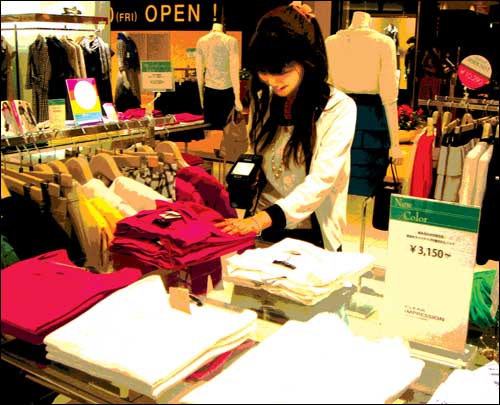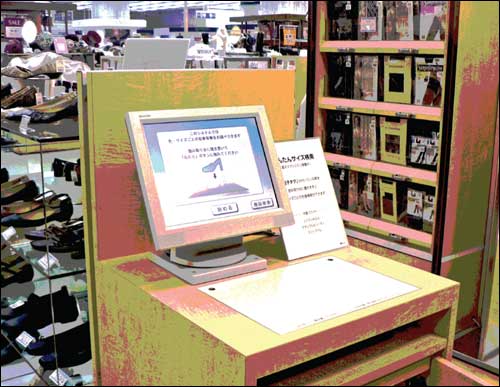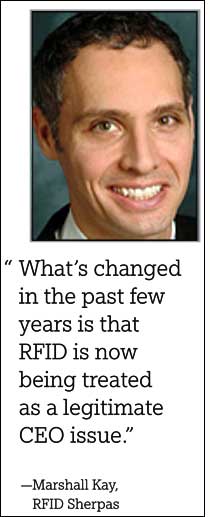Even before the economic crisis, apparel and footwear retailers had recognized the benefits of using item-level radio frequency identification technology in stores to keep shelves stocked, better account for inventory, and reduce theft and loss. Now, retailers in the hard-hit industry are more interested than ever in using item-level RFID to cut losses, improve efficiencies and boost sales. Some retailers are even pushing back RFID tagging to the point of manufacture, so theycan achieve benefits along the supply chain.
The RFID projects winning approval in the apparel and footwear industry promise quick returns on investment. This has been the case with a number of apparel companies that manufacture and sell their own brands at retail stores and have successfully implemented the technology in a closed-loop setting. These retailers include Levi Strauss & Co. in Mexico; American Apparel in the United States; NP Collection in Finland; Eren Holding, the Turkish conglomerate that has territorial rights to produce and sell Burberry and Lacoste; Marks & Spencer in the United Kingdom; and Charles Vögele Group in Switzerland. Recently, department stores including Falabella in South America, Dillard’s in the United States, and Karstadt in Germany, have jumped into the RFID arena, even though it’s more challenging to deploy the technology in an open-loop supply chain.

RFID projects in apparel and footwear remain strong, because the technology is uniquely suited to address the industry’s pain points. In fact, the jury—consisting of retailers that have deployed the technology, analysts, researchers and trade groups—has delivered a unanimous decision when it comes to item-level tagging, summed up by Michael Liard, RFID practice director at ABI Research: “RFID is perfect for fashion, apparel and retail. It says not just what it is, that it’s a Liz Claiborne blouse, but what size, color and SKU, and it provides each item with a unique serial number.”
Since specialty retailers control their own supply chains, they can begin enjoying the benefits of RFID relatively quickly. Department stores and their branded suppliers, by contrast, must as a group coordinate and agree on certain standards to reap the benefits of RFID, says Gay Whitney, standards director for GS1 EPCglobal.
Item-Level Intelligence
Keeping store shelves and racks stocked with the latest fashion apparel is one benefit of item-level RFID tagging. “As you see the retail industry struggling with the economy and see the major layoffs, it’s probably more critical than ever to make sure that when a consumer walks into your store, you have that item out and not in the back room,” says Mary Howell, VP of industry relations for the American Apparel & Footwear Association (AAFA). In footwear, RFID can boost sales by improving customer service.
At American Apparel, a Los Angeles-based retail chain known for wardrobe basics and racy advertisements, it’s store policy for shelves and racks to be properly stocked: All styles must be available in all colors and in at least one of each size. To that end, employees spend 60 to 80 hours per week manually counting T-shirts, jeans and other items. On any given day, they need to restock between 60 and 300 items that are missing from the sales floor.Managers in eight stores in Los Angeles and New York observed a noticeable difference in the accuracy of their inventory and fullness of their sales floor once American Apparel started RFID-tagging all clothing and tracking items with handheld interrogators. After each store had been completely tagged, it was evident that between 1,500 and 2,800 items were not represented on the sales floor.
“An industry study proved that only 8 percent of customers will request an assistant for a size check,” says Zander Livingston, American Apparel’s RFID technology director. “If you’re missing a couple hundred of those or more, you’re reducing your sales potential. My goal was to locate lost stock and get it on display.”
As important as it is to keep store shelves and racks well stocked, it may be even more critical to maintain accurate inventories of what’s in stock, what’s on display and what’s coming. “The killer app, or the killer problem we can solve, is inventory accuracy,” says Bill Hardgrave, director of the RFID Research Center at the University of Arkansas, which found that inventories at U.S. apparel stores are accurate only 65 percent of the time. “In any retail, but particularly important in this industry, inventory accuracy is the foundation upon which ordering and replenishment decisions are made, directly related to out-of-stocks, directly related to sales and directly affecting one’s inventory holding costs. That is really the root of all retail evil.”
Item-level tracking can help solve this problem by giving apparel retailers “item-level intelligence”—something they’ve never had before. “Companies don’t have reliable information about exactly what has been received, where it currently resides in the store and what’s gone missing,” says Marshall Kay, founder of RFID Sherpas, a consulting firm focused on retail RFID. “They rely on frequent visual inventories. What’s exciting about RFID is it allows you to manage a store more intelligently.”
That business intelligence can enable apparel stores to maintain a more accurate perpetual inventory, where inventory quality and availability are updated continually, so retailers know what they have on the sales floor and in the back room, as well as what they need to reorder. This information is particularly important in a down economy, Kay says, because consumers will leave a store if it doesn’t have what they want, and buy it from a competitor that does have the item in stock. Apparel is unlike other products in that a consumer won’t buy a different size of, say, jeans—and if a retailer doesn’t have the item in stock, it may lose the customer for good.
Those competitive factors are among the issues driving department stores to consider deploying RFID. “What’s changed in the past few years is that RFID is now being treated as a legitimate CEO issue,” Kay says. Results from specialty retail chains, which are tagging items at the point of manufacture, also are convincing others to try on RFID for size. American Apparel has seen savings of up to 35 percent in labor in its stockrooms. Finland’s NP Collection found that RFID reduced the time spent receiving goods at its boutique stores by 75 percent. Similarly, German department store Karstadt determined that the technology helped cut the time needed to receive goods into inventory by 85 percent. In all cases, inventory accuracy improved.
In addition, item-level tagging can allow stores to differentiate themselves by offering customers new experiences. “Magic mirrors,” for instance, can read RFID-tagged items and provide details about the product or suggest complementary garments and accessories. “You may be able to communicate from a fitting room if you need another size, so that you don’t have to get dressed and go back out,” says Stephanie Brush, Motorola‘s director of RFID business development for the apparel and fashion market. “The odds are if you get dressed again that you’re going out that front door.”Pushing Back Benefits
Most RFID deployments in the apparel industry to date have been in-store applications. Increasingly, however, retailers are taking the logical next step and RFID-tagging items at the point of manufacture—where they’re already routinely applying hangtags. Source tagging lets companies track the movement of outbound goods through shipping, transfer to and from distribution centers, and on to stockrooms. “Fashion is perishable—the faster you get it from the door to the floor, all the better,” says Motorola’s Brush. “With item-level tagging, you can serve many stakeholders in the value chain when you add the tag at the point of manufacturing.”
It’s also less expensive to RFID-tag apparel at the source if it’s manufactured in Asia, where the cost of labor is lower than in Europe or the United States. Some tag and label suppliers, such as Avery Dennison, operate service bureaus in Asian markets, where they have added RFID tagging to their more traditional lines of garment tags and labels. “Attaching RFID tags is like putting the normal price ticket on, as far as the contractor is concerned,” says Pete Moylan, U.K. head of RFID for Avery Dennison. “The attachment cost is the same. But if you try to do it in a DC in Europe or the U.S., you’ll spend a lot of money tagging.”
Sumikin Bussan—a Japanese company with a $1.6 billion-per-year textile trade, including the manufacture of apparel ranging from T-shirts to leather coats—tested the benefits of item-level tracking from source to store in a 2006 RFID pilot conducted in conjunction with the Japan Apparel Industry Council (JAIC) and supported by the Japanese government’s Ministry of Economy, Trade and Industry (METI). The company had item-level RFID tags applied to garments at the same time as hangtags during manufacture in China. The garments were then inspected and placed in cartons, which also were RFID-tagged with information about the contents. Advance shipping notices were automatically generated before the shipments left Shanghai for destinations in Japan.
“The distribution centers in Tokyo received data in advance and didn’t have to open boxes to see whether they should go to Tokyo or Osaka, or this store or that store,” says Hideki Yamauchi, general manager of Sumikin Bussan and chairman of JAIC’s RFID committee. Boxes didn’t have to be opened at the store level, either. “The store people scanned the box into receiving,” he says.
In November 2008, JAIC started the next phase of this RFID pilot at two apparel stores in Tokyo, this time focusing more closely on operations within the store. RFID can provide a more granular view of product movement than traditional point-of-sale systems, and can shed light on the true level of consumer interest in specific items. This business intelligence can be shared with manufacturers and could impact future design and production decisions.
RFID tagging at the source also has the potential to resolve monetary disputes between retailers and manufacturers, which amount to millions of dollars in discrepancies. “One area where the department store ecosystem can create a win-win is with chargebacks, when the retailer charges back the supplier for product that allegedly was not received,” says RFID Sherpas’ Kay. RFID can help provide a better foundation of data to more accurately resolve these disputes and ultimately reduce the number of claims that get made. “It’s a chronic issue right now,” he says, “one that consumes valuable time, money and energy.”Antitheft Applications
Even with RFID item tracking, inventory accuracy can’t be achieved until retailers find a way to detect and curb theft and loss, also known as “shrinkage.” Shoplifting and theft by dishonest employees cost the retail industry billions of dollars each year.
Shrinkage is magnified by the fact that such losses aren’t reflected in a store’s POS-based inventory system, so goods that are stolen, misplaced or lost don’t trigger an automatic order to replenish stock.
“The impact of that is up to 30 times greater than the initial loss to begin with,” says Paul Cataldo, VP of marketing at Checkpoint Systems, a provider of RF-based loss-prevention systems. “The reason is you have consumers coming to a store to buy an item, and so they just leave if they can’t find it. But if they had bought that item, they probably would have bought other items, too.”
RFID has the potential to help fight theft throughout the supply chain—from the back of a manufacturing facility, during transport from manufacturer to retailer, and when goods are stored in distribution centers or warehouses. The key to thwarting thieves is to know where the product is and who’s handling it. RFID can create an audit trail that can help investigators identify exactly where theft is occurring. “RFID contributes to tighter control over inventory,” Kay says. “It gives you the ability to precisely identify exactly what has been sent and when it has been sent, as well as validate the contents of received shipments, thus establishing a chain of custody.”
To thwart shoplifting, retailers have been using electronic article surveillance (EAS) technologies. But while EAS tags can trigger an alarm, they don’t carry item-level information and can’t tell retailers specifically what items were taken. An RFID-based antitheft solution could trigger alerts and let managers know what needs to be replenished in the store.
Taracci, a Swedish retailer of men’s apparel, deployed an item-level RFID tracking system at its newest store in Stockholm to automate checkouts, improve inventory management and process payments—as well as to deter theft. RFID tags carrying Electronic Product Codes (EPCs) are applied to all items in the warehouse, explains Niklas Hild, a consultant working on the project. If a customer tries to leave an RFID-enabled store without paying for an item, the RFID tag will trigger an alarm from an RFID interrogator at the door. When a customer pays for an item, the alarm is disabled. Taracci estimates that its investment in RFID has a payback period of less than one year. The company has since upgraded existing stores in Stockholm and Brussels with item-level RFID tracking.
But RFID hasn’t been tested extensively as an antitheft solution, and some retailers are loath to install new infrastructure at store doors when they already have EAS readers in place. One solution now being tested is to marry EPC Gen 2 tags with current EAS technologies, and several manufacturers are developing hybrid EAS/RFID tags. EAS technology used in conjunction with RFID “is a great transition tag” for the near term, says Randy Dunn, national sales and marketing director for ADT, which manufactures EAS Sensormatic devices.EPCglobal’s Whitney says a U.S. apparel retailer with $3 billion in annual turnover, which she declined to name, recently implemented an EAS-based RFID tagging solution to manage inventory in fitting rooms. The result, she says, was significantly reduced in-store theft, as salesclerks were aware of which items went into the fitting rooms and could ask for those items when the customer left the room.
In March, EPCglobal created a Joint Requirements Group to look at developing technology standards and privacy guidelines for retailers interested in deploying an EPC-based RFID solution for EAS and loss prevention. Many apparel retailers, including department stores, are waiting for the industry to develop such standards before they adopt item-level tagging, Whitney says.
C&A, an apparel chain with 1,500 stores in Europe, began a program in 2007 to apply EAS tags at the source of manufacture. The chain wants to upgrade to an EPC-based RFID solution for EAS, but it’s waiting until standards are in place. “We are not going to introduce RFID in our stores when it’s not clear what the regulations we need are,” says Joachim Wilkens, program officer responsible for RFID at C&A.
The Bottom Line
While some apparel companies are keeping their RFID pilots close to the vest for competitive reasons, other public—and successful—deployments are spurring adoption throughout the industry. In addition, new technology developments that promise to help improve sales could encourage retailers to consider RFID. An interactive tag from startup VRF Holding, for example, could reduce the costs associated with markdowns by allowing markdown information to be transmitted to the tag via radio waves. The tag uses “electronic ink” to display the new price and the markdown amount. The tag could also be used to mark up hot items, enabling companies to optimize pricing and increase revenue.
As apparel companies look at the early adopters to learn how to deploy item-level tagging successfully, they should note the importance placed on educating consumers about RFID and addressing their concerns that the technology could reveal personal information about purchases. In Germany’s Metro and Galeria Kaufhof stores, for instance, signs inform customers that RFID technology is in use, and why.
At American Apparel, privacy “hasn’t been an issue at all,” Livingston says. The company posts signs in RFID-enabled stores informing customers that RFID chips are embedded in the tags. But those chips contain no information other than a 96-bit encrypted code, he says. The code is useful only when tied to the company’s database. In addition, store clerks offer to remove the tag upon sale, if the customer wishes.
“You have to let your customers know what’s in it for them,” says ABI’s Liard. Customer benefits include more items in stock, fitting rooms with magic mirrors, faster checkout and even lower prices if theft is curbed. The question of removing the RFID tag at the point of sale might come down to choice, he says. If consumers understand that keeping the RFID tag attached might help facilitate returns, they might want to leave it as is.
The fashion industry’s adoption of RFID may ultimately be determined by the bottom line. If the economy fails to climb back to pre-recession figures, that may make investing in RFID more difficult for some apparel retailers and manufacturers. But there are two sides to the coin. “You’re going to have less of a sales force now,” says AAFA’s Howell. “Having RFID to be able to take that inventory, scan inventory in the back room and do that replenishment is critical moving forward.”Footwear Stores Step Into RFID
Customers buying shoes at some stores in Japan these days are likely to receive better and faster service, thanks to an RFID system developed by the Japan Department Stores Association (JDSA) to help sales associates quickly locate footwear. The system allows the associates to look up information at RFID kiosks on the sales floor about the availability of footwear by style, number, size and color. The footwear, located in a store’s stockroom, is RFID-tagged at wholesalers’ distribution centers.
The system was developed after a 2004-05 pilot in the women’s shoe department of Mitsukoshi‘s flagship store in Tokyo found that tagging shoe boxes or individual pairs of shoes cut the time consumers had to wait for shoes in half. A report on this pilot by Kurt Salmon Associates indicated that RFID helped increase the number of pairs of shoes shown to customers from 1.8 to 3 every 12 minutes. It also enabled the store to send demand signals back to the manufacturer more quickly, expediting replenishment. In late 2006, after extending its use of RFID to multiple stores, Mitsukoshi reported a 13.3 percent sales lift in women’s footwear at the stores using RFID.

The JDSA designed the collaborative RFID system, introduced in 2006, so it could be used by multiple stores and wholesalers. At present, 25 stores from eight different chains are using the system, and the association believes that other Japanese retailers will soon adopt RFID tracking. The system improves the flow of information between wholesalers and department stores, so the wholesalers can keep better tabs on which shoes are selling.
“At the moment, it is difficult to measure financial return by RFID implementation,” says Atsuhiro Seki, JDSA manager. “However, department stores are satisfied with the results of this system. Customer waiting time has been actually shortened, and now shop staff can provide customers with better service.”
Footwear chains outside Japan also are experimenting with RFID tracking. In March, Jones Apparel Group, designer and owner of the Nine West chain of women’s footwear and accessory stores, finished a pilot at two of its Nine West retail stores—one in New York City and an outlet store in the greater metropolitan area. The chain is still reviewing the results, but the pilot “has certainly captured the interest of senior executives,” says Marshall Kay, founder of RFID Sherpas, which is consulting on the project.
“Keep in mind that, with the obvious exception of outlet stores, footwear is usually stored in a stockroom and not on the selling floor,” Kay says. “You have sales associates constantly running back and forth to the stockroom, sometimes going up and down flights of stairs. Often, they don’t have a good idea whether the requested shoe is going to be there.”
If footwear boxes are RFID-tagged and sales associates are given handheld devices networked with a real-time RFID inventory system, the associates can quickly determine which shoes they have in stock, in what colors and sizes, without ever leaving the sales floor. In addition, this opens the door to what Kay refers to as inverse selling. If, for example, a customer wants a pair of black pumps and she wears size 7, the associate now has the ability to walk the floor with the customer and point out each and every style of black pump available in her size.
“You want your associates to be as efficient as possible, so they can make each customer’s visit as productive and successful as possible,” Kay says. “These tools help them have meaningful interactions with a greater percentage of customers who walk through the front door.”




